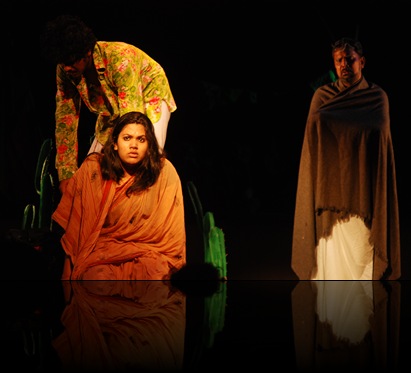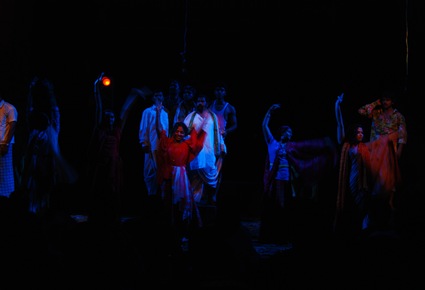LOST IN FAKE HEAVENS
This is the report that came in New Indian express daily Cochin edition on 3rd October 2009, as a curtain raiser to our premiere of the play Abhayarthikal. Photo Gireesh Menon
LOKADHARMI will present its new play "Abhayarthikal" on october 3 and 5 at Changampuzha Park,Edapally.Based on the drama written by G.Shankara Pillai,"Abhayarthikal" throws light on the disintegration of family and social structure.
Designed and directed by Prof.Chandradasan,it will be a new experience for Kochiites as this highly Ibsenesque play will be performed in open air.Though the drama was written in 1965,it has rarely been performed in Kerala.
Three different plots are interwoven in this play and it depicts the social situation and concerns of the Kerala society at that period.The arrangement and structure look realistic in nature and the characters are often caricatures.The play is set in a village railway station in the darkness of night.All the characters are waiting for a train to come and have their own reasons for being there.The play looks into the refugee in every human and the sense of insecurity irrespective of "having a home'.There is the presence of some north-indian refugees settled nearby and there presence reaches the stage mostly through sounds and songs.
The main characters in the play are Janaki,a woman in her 30s,Prabhakaran,a young man in search of his lady love and an old man waiting for his son to return from the army. There are also a bridegroom,a politician and Arishttam Kittan,an illicit liquor peddler.
The play hints at the breaking up and disintegration of the social structure based on solid families.Janaki,the heroine,breaks the family and comes out.The encounter between Janaki and her husband in the final sequence is eloquent enough to suggest the falsity of the concept of a smooth and enduring family set up.
The setting and atmosphere are more important than the characters in communicating the feel and meaning of the play.The rural railway station,the cement benches,the tree with flowers,the ground with a spread of fallen flowers,the lamp post etc enhance the significance of the whole enactment.The play takes place mostly in the dark and the characters have the tendency to merge into the darkness.
The play breaks away from the proscenium and is performed underneath a tree.The treatment of the play is direct and simple,and avoids all the theatrical jargon,clichés and set models of blocking, and technique.
The play will begin at 6:30 pm.
Labels: ABHAYARTHIKAL, Chandradasan, G Sankara Pillai, Lokadharmi





